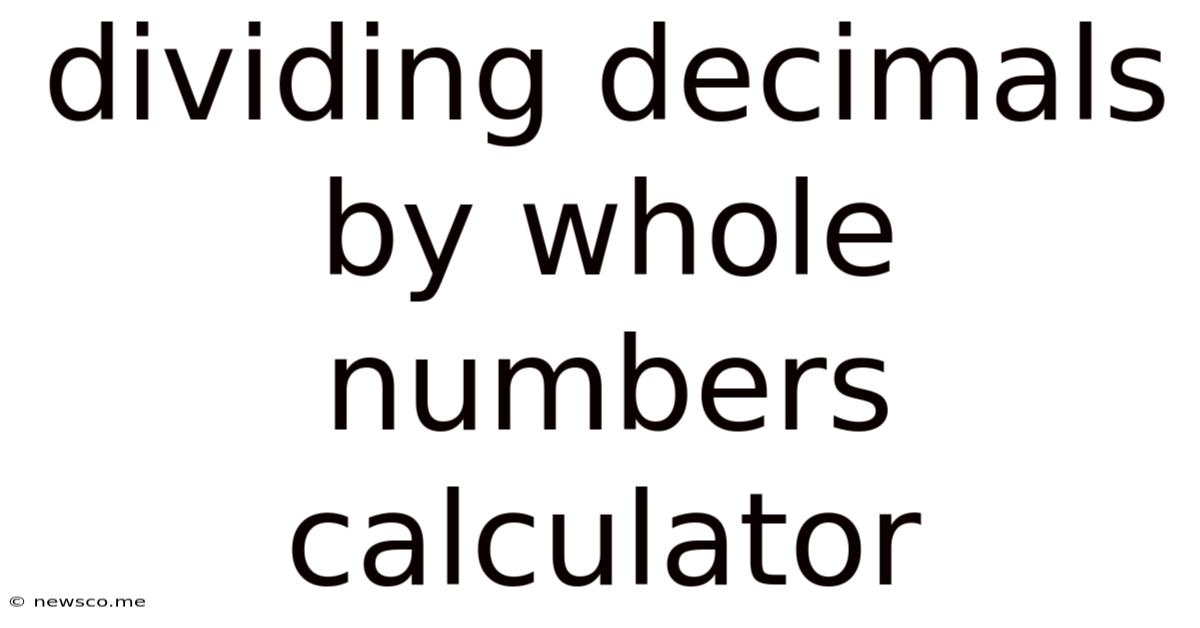Dividing Decimals By Whole Numbers Calculator
News Co
Mar 23, 2025 · 4 min read

Table of Contents
Dividing Decimals by Whole Numbers: A Comprehensive Guide
Dividing decimals by whole numbers might seem daunting at first, but with the right understanding and a few helpful tools, it becomes a straightforward process. This comprehensive guide will walk you through the steps, explain the underlying principles, and even introduce you to using a calculator to streamline the process. We'll explore various methods, focusing on manual calculation as well as leveraging the power of a calculator, all while aiming to build a strong foundation in decimal division.
Understanding the Fundamentals: Decimals and Whole Numbers
Before diving into the division process, let's refresh our understanding of decimals and whole numbers.
Whole Numbers: These are numbers without any fractional parts. They include 0, 1, 2, 3, and so on. They represent complete units.
Decimals: These numbers include a fractional part, separated from the whole number part by a decimal point (.). For example, 2.5, 10.75, and 0.05 are all decimals. The digits after the decimal point represent parts of a whole.
The Importance of Place Value: Understanding place value is crucial in decimal division. Each digit in a number holds a specific value based on its position relative to the decimal point. For example, in the number 123.45, the '1' represents 100, the '2' represents 20, the '3' represents 3, the '4' represents 4/10, and the '5' represents 5/100. This understanding is vital for correctly aligning digits during division.
Manual Division of Decimals by Whole Numbers: A Step-by-Step Guide
Let's tackle the process of dividing decimals by whole numbers manually. We'll use the example of dividing 12.6 by 3.
Step 1: Set up the Long Division Problem:
Write the problem in the standard long division format:
_____
3 | 12.6
Step 2: Ignore the Decimal Point (Initially):
For now, ignore the decimal point in the dividend (12.6). Treat it as if you're dividing 126 by 3.
Step 3: Perform Long Division as Usual:
Proceed with long division as you would with whole numbers:
42
3 | 126
-12
06
-6
0
Step 4: Place the Decimal Point:
Now, bring the decimal point straight up from the dividend to the quotient:
4.2
3 | 12.6
-12
06
-6
0
Therefore, 12.6 divided by 3 is 4.2.
Handling More Complex Scenarios
Let's explore some more challenging scenarios:
Scenario 1: Dividing a Decimal with More Than One Digit After the Decimal Point
Let's divide 37.85 by 5:
- Set up the long division:
5 | 37.85 - Ignore the decimal point initially:
5 | 3785 - Perform long division:
757 5 | 3785 -35 28 -25 35 -35 0 - Place the decimal point:
7.57
Therefore, 37.85 divided by 5 is 7.57.
Scenario 2: Dividing When the Dividend Doesn't Divide Evenly
Sometimes, you'll have a remainder. Let's divide 23.7 by 4:
- Set up the long division:
4 | 23.7 - Ignore the decimal point initially:
4 | 237 - Perform long division:
59 4 | 237 -20 37 -36 1 (remainder) - Place the decimal point and consider the remainder: The remainder of 1 can be expressed as a fraction (1/4) or a decimal (0.25). So we would write 5.925.
Therefore, 23.7 divided by 4 is approximately 5.925
Using a Calculator for Decimal Division
Calculators provide a quick and efficient way to divide decimals by whole numbers. Most standard calculators have the functionality to handle this type of calculation directly.
Steps to Use a Calculator:
- Enter the dividend (the number being divided).
- Press the division symbol (÷).
- Enter the divisor (the number you're dividing by).
- Press the equals symbol (=). The result (quotient) will be displayed.
Practical Applications of Decimal Division
Understanding and performing decimal division has numerous practical applications in various fields:
- Finance: Calculating unit prices, splitting bills, calculating interest, determining discounts.
- Measurement: Converting units (e.g., meters to centimeters, kilometers to miles), calculating averages.
- Science: Analyzing experimental data, calculating concentrations, solving physics or chemistry problems.
- Everyday Life: Sharing costs equally, calculating fuel efficiency, determining portion sizes for recipes.
Troubleshooting Common Mistakes
- Decimal Point Placement: The most common error is incorrectly placing the decimal point in the quotient. Always bring it straight up from the dividend.
- Long Division Errors: Double-check your subtraction and multiplication steps during long division to avoid errors that propagate through the calculation.
- Calculator Errors: Ensure you enter the numbers correctly into your calculator.
Advanced Concepts and Further Exploration
For those seeking a deeper understanding, consider exploring these concepts:
- Dividing by Decimals: The method differs slightly when dividing by decimals; you'll need to adjust the decimal points in both the dividend and divisor.
- Repeating Decimals: Understanding how to express repeating decimals (e.g., 1/3 = 0.333...) in different forms.
- Scientific Notation: Using scientific notation to represent very large or very small numbers simplifies division.
Conclusion
Mastering decimal division is a crucial skill with broad practical applications. While manual calculations provide a deeper understanding of the underlying principles, calculators offer a convenient and efficient solution for everyday use. By understanding the fundamental steps and utilizing available tools, you can confidently tackle decimal division challenges in various contexts. Remember to practice regularly to strengthen your skills and build confidence in tackling more complex problems. The more you practice, the easier it will become.
Latest Posts
Related Post
Thank you for visiting our website which covers about Dividing Decimals By Whole Numbers Calculator . We hope the information provided has been useful to you. Feel free to contact us if you have any questions or need further assistance. See you next time and don't miss to bookmark.